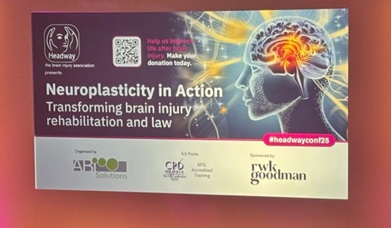
The ABI Solutions, Headway Neuroplasticity in Action conference, held on Friday 10th October, brought together a diverse community of clinicians, researchers, and rehabilitation specialists to explore how science continues to redefine recovery following acquired brain injury (ABI).
For us, it wasn’t just a day of academic insight, it was a reminder of how far we’ve come in understanding the brain’s capacity to adapt, and how much potential still lies ahead. Here’s what stood out:
The event provided an in-depth look at how far our understanding of neuroplasticity has evolved, and how those insights are being translated into practical, life-changing interventions.
Neuroplasticity describes the brain’s remarkable ability to reorganise and adapt, which has moved from theory to tangible application over the last decade. What was once regarded as a limited process primarily confined to early development is now recognised as a lifelong capacity for change. The conference showcased how this evolving science is reshaping rehabilitation, with a strong emphasis on collaboration across disciplines and the integration of behavioural, cognitive, and physical therapies.
Just 3 TBI’s dramatically reduces your cognitive abilities a 50 years of age
Emerging Approaches and Innovative Practice
One of the strongest themes to emerge was the shift towards active engagement in rehabilitation. Presentations demonstrated how interventions that demand purposeful, repetitive movement, supported by real-time feedback, can drive measurable neurological change. From virtual reality-based rehabilitation to task-specific training and sensory modulation techniques, the focus was clear: neuroplasticity thrives on meaningful, consistent input.
Speakers also highlighted advances in neuroimaging that are allowing clinicians to monitor and visualise changes in brain connectivity throughout recovery. These developments are providing fresh insight into which interventions produce the most sustainable improvements, and why timing, intensity, and motivation play such pivotal roles.
A recurring message across the sessions was that the best outcomes arise from an integrated approach. No single therapy stands alone; rather, progress depends on aligning physical rehabilitation with cognitive retraining, emotional regulation, and environmental adaptation. This multidisciplinary ethos is becoming increasingly central to modern neurorehabilitation programmes.

The Human Element: Context and Environment
While technology continues to open new doors, many of the most compelling discussions returned to a fundamental truth: the brain rewires in response to experience.
Speakers explored how environmental and behavioural cues can either support or inhibit neuroplastic change. A structured, positive, and emotionally safe setting was shown to have profound effects on engagement and motivation, both critical ingredients for meaningful recovery.
Several presenters stressed the importance of building contextual relevance into therapy, ensuring that exercises and routines connect to real-world function rather than existing in isolation. In other words, it’s not simply about movement, it’s about movement with purpose.
These insights align closely with broader behavioural frameworks, recognising that rehabilitation does not occur in a vacuum. The patient’s social environment, their sense of autonomy, and even subtle nonverbal factors, such as tone, posture, and proximity, all influence the outcome.
Bridging Research and Practice
One sobering takeaway was the recognition that innovation doesn’t automatically translate into implementation. Despite the clear progress, the conference also addressed the gap that often exists between academic research and practical implementation.
Barriers such as funding constraints, uneven service provision, and limited access to post-acute support continue to restrict the widespread adoption of evidence-based interventions.
Speakers called for stronger communication between researchers and front-line practitioners to ensure that promising studies translate into scalable, sustainable change. There was also discussion about the ethical and regulatory considerations of emerging neurotechnologies including brain-computer interfaces and AI-driven rehabilitation tools. The consensus: innovation must always be balanced with responsibility and patient safety.
As we look ahead, one of the most inspiring takeaways from Neuroplasticity in Action was the renewed sense of optimism permeating the field. The narrative surrounding brain injury is shifting, from one of limitation to one of potential. Recovery is no longer viewed as a process of simply compensating for loss but as an opportunity to re-engineer the neural pathways that underpin movement, cognition, and behaviour.
The event served as a reminder that neuroplasticity is more than a biological mechanism; it is a framework for resilience. It challenges professionals to think not just about what the brain can do, but what conditions allow it to do it best.
For clinicians and therapists working in brain injury rehabilitation, that means creating environments where repetition meets relevance, where science meets empathy, and where every small victory reinforces the brain’s capacity to adapt.

The conference underscored that progress in this field depends as much on human connection and contextual understanding as it does on scientific innovation. The intersection of technology, therapy, and lived experience continues to define the next chapter in brain injury rehabilitation, one where recovery is not merely hoped for, but actively engineered through purposeful, evidence-based practice.
If you’re a clinician, therapist, or researcher working in brain injury rehabilitation, we’d love to hear your experiences.
What strategies or innovations have you found most effective in supporting neuroplastic change? Join the conversation in the comments or connect with us to explore collaborative opportunities, because together, we can turn potential into practice.
Written by Gary Simpson, Business Manager
